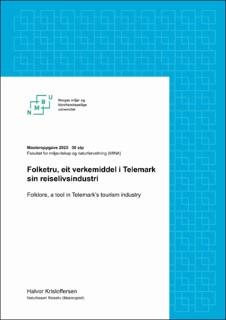| dc.contributor.advisor | Lovisa Ulrica Molin | |
| dc.contributor.advisor | Hilde Nikoline Hambro Dybsand | |
| dc.contributor.author | Kristoffersen, Halvor | |
| dc.date.accessioned | 2023-07-06T16:29:31Z | |
| dc.date.available | 2023-07-06T16:29:31Z | |
| dc.date.issued | 2023 | |
| dc.identifier | no.nmbu:wiseflow:6839585:54592377 | |
| dc.identifier.uri | https://hdl.handle.net/11250/3076837 | |
| dc.description.abstract | Denne studien bygger på ei kvalitativ undersøking der semistrukturerte djupneintervju har
blitt nytta for å undersøke korleis folketru blir bruka som verkemiddel i reiselivet i
Telemark. Formålet med oppgåva har vore å sjå om dette kan styrke relasjon til natur og på
denne måten auke miljøbevisstheita blant turistar. Ulike bedrifter i Telemark har blitt
intervjua for å kunne svare på denne problemstillinga. Desse bedriftene er knytt til eit
område med rik kulturarv der ressursgrunnlaget for bruk av folketru er stort. Det blei difor
undersøkt om bruk reflekterast av det store ressursgrunnlaget.
Funna i denne masteroppgåva viser at ressursgrunnlaget for bruk av folketru er særs høgt i
Telemark. Dette utnyttar bedriftene der på ulike måtar. Gjennom blant anna
destinasjonsutvikling, marknadsføring, storytelling og guiding brukast folketru for å legge
til rette for opplevingar for turistar. Desse opplevingane har ofte som formål å skape ein
nærare relasjon til naturen med eit mål om å auke miljøbevisstheita til turistane.
Storytelling og integrasjon blir bruka for å skape ein samanheng mellom det fysiske
landskapet og den immaterielle kulturarven. På denne måten kan folketru oppmode til vern
av ulike naturområde. Den ibuande berekraftige filosofien som finnast i folketru støtter opp
under dette. Det finnast likevel utfordringar ved å nytte folketru som kan få følgjer for både
miljø, autentisitet og identitet. Å møte desse utfordringane i framtida kan bli relevant for
bedriftene i Telemark å ta omsyn til om folketrubasert turisme skal vidareutviklast. | |
| dc.description.abstract | This study is a qualitative research paper which utilises semi-structured in-depth interviews
to investigate how folklore can be used as a tool within the tourism industry in Telemark,
Norway. The purpose of this paper has been to investigate if this can increase relation to
nature and therefore strengthen the environmental consciousness among tourists. Different
tourism companies in Telemark have been interviewed to answer this question. These
companies have their workplace in areas which are heavily associated with immaterial
cultural heritage. This paper therefore investigates how the utilisation of folklore reflect the
resource base of the region.
The findings show that the resource base for using folklore as a tool is quite large.
Tourism companies in Telemark utilises this in different ways. Through destination
development, marketing, storytelling and guiding, folklore is being used to facilitate
experiences for tourists. The intention behind these experiences is to create stronger human
and nature relations to further increase environmental consciousness among tourists.
Storytelling and integration are used to create a coherence between the physical landscape
and the immaterial cultural heritage. Through this method folklore can encourage
environmental protection. The inherent sustainable philosophy that is present within
Norwegian folklore supports this. There are still challenges when it comes to utilising
folklore in a commercial way. It can lead to negative effect on both environment,
authenticity and identity. These challenges can become more prominent in Telemark in the
future, and it is therefore necessary for the companies to acknowledge this and prepare if
folklore based tourism is to be developed further | |
| dc.language | nno | |
| dc.publisher | Norwegian University of Life Sciences | |
| dc.title | Folketru, eit verkemiddel i Telemark sin reiselivsindustri | |
| dc.type | Master thesis | |
